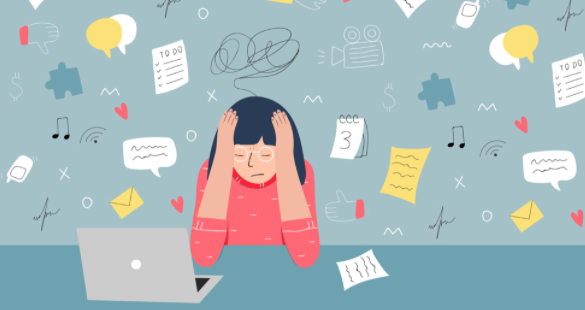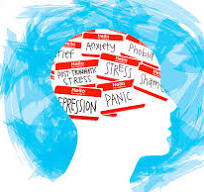A High School Burnout: Today’s High School Anxiety Epidemic

November 8, 2021
As pressure increases for many students across the district, adverse effects of high pressure schooling such as schedules loaded with AP courses as well as extracurricular activities begin to show their mark on students and their mental health. When schools first closed in 2020 we had no idea what the loss would mean to students and their development. Now with schools back open, we can see the effects of hybrid and online schooling.
Across Massachusetts MCAS test scores show what we lost through online schooling, “Overall, 46 percent of students in grades 3-8 scored Meeting Expectations or higher in English language arts in 2021, and 33 percent did so in math. Both of these represent a drop compared to 2019, when 52 percent scored at that level in English language arts and 49 percent did so in math,” says the Department of Elementary and Secondary Education. These scores, especially math scores, show a worrying decline in comprehension among students.
Now back “in person” schools are feeling the pressure to raise test scores, and the students feel it too. When asked if students feel added pressure to raise standardized test scores, students answered affirmatively, “…I think that just comes with high school, but I don’t know if that would’ve been the same if there wasn’t a pandemic,” says Laila Rodene, a freshman at Waltham High School.
Staff answered similarly. “I think people are concerned about MCAS scores because of the two years that people were not here,” answered Nicole Fournier, a WHS guidance counselor. When asked about common classes students struggle in, math was one of the biggest answers, closely matching the MCAS data.
Another concern was adjusting into school. “The fact that we never adjusted to school took a toll on my mental health,” says Rodene. Staff agrees with this, saying that even more important than raising test scores is adjusting to this “new normal.” According to Fournier, “It’s more that students need to get used to being students in a school again as opposed to the stuff they need to learn.”
College admissions are another source of stress, especially among seniors. The source of some of this stress, Fournier says, is caused by the pandemic, “I think a lot of that has been because of the lack of the ability to visit colleges. It’s kinda like you’re almost applying blind.”
All of this is taking a toll on students and their mental health. Not only has the pandemic harmed students’ academic abilities and upperclassmen attending college, it has had a significant impact on adolescent students’ emotional wellbeing. For teenagers, the pandemic’s restrictions meant months of virtual schooling, less time with friends, and the cancelling of activities such as sports and proms. Staying at home seemed to lessen some fears of being sick, but isolation has its own set of problems. It’s exceedingly difficult and unpleasant to be away from the comfort and company of friends and family. Social isolation can lead to feelings of loneliness, depression, and anxiety, even when you’re around your family.
When asked if being home during online schooling took a toll on mental health one student answered affirmatively saying, “It definitely did, I didn’t really have a lot of friends. It was really lonely and I felt really distanced” according to sophomore Ava DiMatteo.
When you put faces and voices to the numbers, you’ll find that they all share similar feelings about virtual and remote learning during the pandemic. Stress is a common topic among high school students, and it comes up frequently in discussions about the many problems students endured this past year. The COVID-19 virus has had a huge and widespread influence on mental health around the world. Nearly everyone who is impacted by or experiences such worldwide events experienced some amount of psychological distress. The COVID-19 pandemic brought not only the threat of infection-related death, but also intolerable psychological stress.
Results from the National Center for Biotechnology information show, “that about 88% of students experienced moderate to severe stress, with 44% of students showing moderate to severe anxiety and 36% of students having moderate to severe depression.” These numbers offer you a better idea of how much the measures taken to help prevent the pandemic from spreading only cheated and afflicted the kids.
However, despite the comfort of learning from home, kids at home showed little to no development while learning from their beds. When we asked a sophomore who’s years were cut short during 7th and 8th grades leaving 6th grade to be her only normal year if she had felt as though she regressed in school and learning during the pandemic this is what she said, “Yes, I think I definitely gave a lot more effort but I did think it was definitely difficult,” shared DiMatteo. Suspension of face-to-face instruction in schools during the COVID-19 pandemic has led to concerns about consequences for students’ learning.
Anxiety is a common feeling in everyone, and having nervous sensations from time to time is a natural reaction, but what some people don’t realize is that these uneasy, pit-of-the-stomach feelings can be easily alleviated. But before we can make out what we can do to help students understand how to better treat their problems, we have to recognize the red flags that come along with anxiety. According to WHS health teach Patty Connors-Beck, “Some warning signs I tend to see are weight loss, kids are starting to lose weight, they are distracted in class, a class they had a ton of interest in, they’re coming in late, skipping classes, not present, doing their own thing and not paying attention.”
Students with anxiety are at risk of low academic performance in school and resistance to school-related activities, it grips the brain and effectively shuts it down. The red flags show us what we need to know about anxiety induced illnesses, but is there a common trend of stress between different levels of high school students? “No, kids with hard home lives, more kids get depressed this time of year but in terms of types of kids, no. But if we compare freshmen to seniors there are different levels of stress. Freshman stress about getting new friends and stupid things they do outside of school compared to seniors they’re more (stressed) about college and finishing stuff. If they don’t want to get into college then what do they do, it’s the end of their rope,” said Connors-Beck. This statement further illustrates the many different types of anxiety-inducing decisions that high school students encounter on a daily basis.
The beginning and end of a student’s freshman and senior years mark the beginning and end of an important chapter in their lives. Not only does an individual develop a sense of self, but they also grow as a person and must learn to balance new stresses in their lives. The good news is that recovery is achievable; but, for many people in recovery, anxiety might persist, though to a reduced degree. However, there are a variety of healthy coping techniques that can help not only with the immediate symptoms of anxiety, but also help anxiety go away all together. Such things as meditating, exercising, talking to someone, distancing yourself from your phone, and doing something you enjoy are all efficient ways you can cope with anxiety.
All these resources point to increased anxiety and depression among students, making this a persistent issue in schools. If you or someone you know is experiencing symptoms of anxiety or depression, know that you are not alone. Resources at Waltham High School such as school adjustment counselors and more are open for any student who feels they need it. Anxiety and depression are nothing to be ashamed of.










